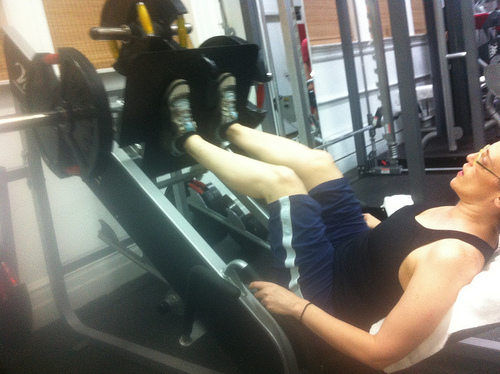- You are here:
- Home »
- Blog »
- Training »
- What muscles does the leg press work?
What muscles does the leg press work?
Most people can figure out the the leg press machine works out the legs, but how you use the machine can impact what muscles are targeted the most. So what muscles does the leg press work?

Photo By: bettyx1138
Muscles directly worked – quadriceps, gluteus maximus
Muscles indirectly worked – hamstrings, calves
The quads are usually the primary target muscle, depending on your foot location on the pad. The glutes also perform some of the work here. Hamstrings and calves are also targeted, but the extent depends on foot placement.
You can actually blast the calves directly in a superset after doing the leg press by having just your toes on the bottom of the foot pad and pressing out with just your toes. If you are already laying down there, you might as well get some extra work in.
There are different styles you can use on the machine to target your lower body muscles in different ways. For instance, a closer stance will target your outer quadriceps more, while a wider stance will work the inside of your quads more.
Also, if your machine is tall enough, you may have some other options. Putting your feet towards the bottom of foot area will target your quadriceps more. If you put your stance towards the top of the foot pad, you will activate your hamstrings and glutes more.
You can see a proper demonstration of the leg press exercise using a machine in the video below. It is recommended that you have a stance that points your knees slightly out, to take pressure off of your knees. You remove the safety and slowly lower the weight towards your chest. Don’t get crazy and go too deep, because that can put extra and unnecessary stress on your legs.
eMany people like the leg press machine, because they can really load up plates on the side and that makes them feel strong. I’ve written before about how that isn’t necessarily the best thing for you and why you may want to consider some alternative exercises to try instead.
Basic squats and all their variations are great exercises to use in their place. Back squats and front squats can both be used as primary lower body exercises. Both will hit the quads and really activate the glutes and hamstrings even more. They also have the added benefit of working your core.
If you use the leg press as a supplementary exercise after squatting, there are plenty of other options as well. You can perform different types of lunges, step ups, and even the hack squat machine. The hack squat machine actually works the muscles in a very similar manner, but your body is flipped upside down as the machine is built differently.
Lunges and step ups also hit the same muscle group, but they are single leg exercises where as the leg press works both legs at the same time. That’s ok, because it is good to do both single and double leg work. Traditional lunges, reverse lunges, side lunges, and step ups of all different heights will work just fine.
Basically, because the leg press is a machine exercise, you will miss out on some of the benefits of using free weights if it is your only, or one of your primary, lower body lifts. That doesn’t mean you can never use it, but you should consider moderation and definitely incorporate some variety.
The leg press machine can be a great exercise for specifically targeting lower body muscles. While it might not be the most exciting lift or very functional for athletes, it absolutely has its benefits and can have a place in most training programs.
Unless you can’t for some medical reason though, I would definitely consider it as only a supplementary exercise that can be used on occasion. While it does have some benefits, there are other exercises that will hit those muscles more efficiently, so be sure to use plenty of variety.
The exact muscles worked in the leg press depends on the style you use on the machine. Obviously the primary targets are the muscles in the lower body, but varying your stance width and foot placement can put a greater emphasis on different muscle groups.

